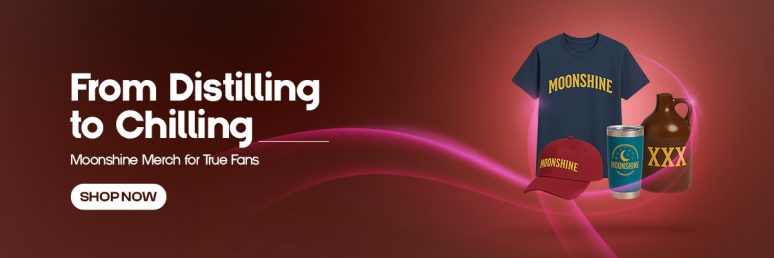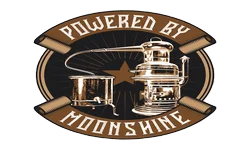Moonshine Potency and Aging: Does It Really Get More Powerful Over Time?
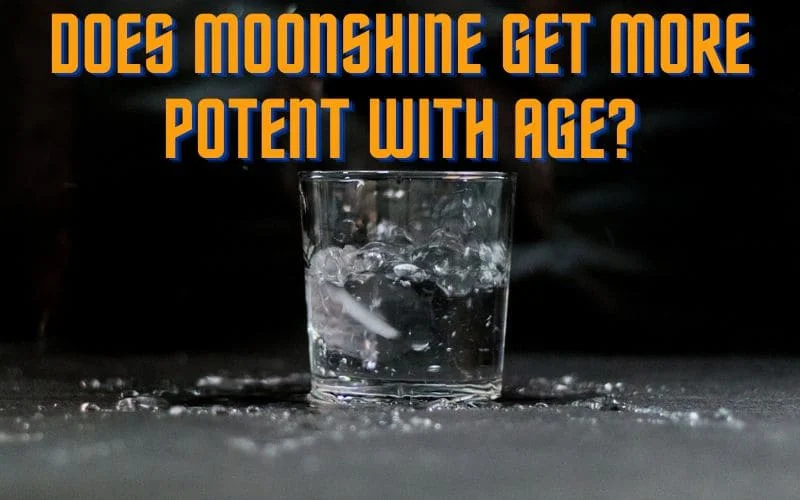
Key Takeaways
- Contrary to popular belief, moonshine does not increase in alcohol content or become more potent as it ages—the ABV remains stable after distillation.
- Aging moonshine in oak barrels or with oak chips can dramatically improve flavor and smoothness, creating the illusion of increased strength.
- Proper storage conditions, particularly in glass containers away from light and heat, preserve moonshine quality for years without affecting potency.
- The perception that aged moonshine is “stronger” comes from flavor concentration and reduced harshness, not actual increases in alcohol content.
- Traditional aging methods like using charred oak can transform raw moonshine into a more complex spirit with whiskey-like characteristics.
I’ve heard it countless times from fellow distillers: “My granddaddy’s shine got stronger the longer it sat.” It’s one of those persistent beliefs that’s been passed down through generations of moonshine makers. But is there any truth to the idea that moonshine increases in potency as it ages? The short answer might surprise you.
After years of hands-on experience and conversations with distillers across Appalachia, I’ve discovered the science doesn’t support this common moonshine myth. While aging absolutely transforms your spirit, it’s not in the way most people think. Understanding what really happens to moonshine over time will help you create better spirits and appreciate the true art of aging white lightning.
Truth About Moonshine Aging – Quick Facts
Moonshine is essentially a clear, unaged whiskey that typically ranges from 40% to 60% alcohol by volume when properly made. Once distilled and sealed, the actual alcohol percentage doesn’t increase with time. What does change dramatically is the character, flavor profile, and perceived strength of the spirit. Many home distillers mistake the improved smoothness and developed flavors for increased potency, when in reality, the alcohol content remains stable or might even decrease slightly through evaporation.
The Reality: Moonshine Doesn’t Get Stronger With Age

“750ml Glass Moonshine Jug with handle …” from stampedestills.com and used with no modifications.
The fundamental truth that many home distillers misunderstand is that fermentation (which creates alcohol) stops completely once distillation occurs. After your moonshine has been run through the still, collected, and sealed in a container, no additional alcohol is being produced. The existing ethanol molecules don’t multiply or concentrate further in the jar. In fact, if anything, poorly sealed containers might allow some alcohol to evaporate over time, potentially reducing the overall proof slightly.
What many mistake for increased potency is actually the significant improvement in drinkability. Fresh moonshine can be harsh with a strong alcoholic burn that masks its true strength. As it ages and mellows, that harshness diminishes, allowing you to better taste the full potency that was always there. It’s not that your shine got stronger—you can just better appreciate its true character without the distracting burn.
The Science Behind Moonshine’s Alcohol Content

“Custom 55 Gallon Moonshine Still (Rocky …” from www.acecustomcopper.com and used with no modifications.
To understand why moonshine doesn’t increase in strength over time, we need to look at the basic chemistry involved. Alcohol (ethanol) is created during fermentation when yeasts convert sugars into alcohol and carbon dioxide. This process stops entirely once distillation begins, as the heat kills the yeast. The distillation process itself merely separates and concentrates the alcohol that was already created during fermentation. For more information on common misconceptions, check out 5 Moonshine Myths.
When properly sealed, the chemical composition of moonshine remains remarkably stable. Unlike wine or beer, which can continue to ferment in the bottle under certain conditions, distilled spirits are too high in alcohol content for any remaining yeasts or bacteria to survive and create more alcohol. The basic chemical profile you’ve created through distillation is essentially fixed, with only subtle changes occurring through oxidation and extraction of compounds from wood if you’re aging in barrels.
What Happens Chemically During Storage
During storage, several chemical processes occur that affect flavor but not alcohol percentage. Oxidation is one of the primary reactions, where oxygen molecules interact with compounds in the moonshine, breaking down harsh congeners (byproducts of fermentation) into smoother, more palatable substances. This process can reduce the burning sensation when you drink it, creating an illusion of changed potency.
If stored in wood, extraction is another key process. The spirit pulls compounds like vanillin, tannins, and other flavor molecules from the wood, adding complexity and color. These compounds don’t affect the alcohol content but significantly change how we perceive the spirit on our palate. Esterification also occurs over time, where acids and alcohols already present in the moonshine combine to create new flavor compounds called esters, which often have fruity or floral characteristics.
“The magic of aging isn’t about making shine stronger—it’s about transforming a rough spirit into something with character and nuance. The alcohol content remains the same, but everything else about it changes.” — Third-generation Appalachian distiller
Why Proof Remains Stable Over Time
Proof stability comes down to basic physics and chemistry. In a properly sealed container, the equilibrium between liquid and vapor phases maintains a consistent alcohol concentration. While microscopic amounts of alcohol might evaporate into the headspace of a container, this reaches equilibrium quickly and doesn’t significantly change the overall proof of the liquid. This is why properly made and stored moonshine can maintain its proof for decades.
The Evaporation Myth Explained
Many home distillers mistakenly believe that as moonshine sits, it “loses water” while retaining alcohol, resulting in a higher proof over time. This misunderstanding stems from observing the “angel’s share” in commercial whiskey aging, where some liquid evaporates through wooden barrels. However, in sealed glass containers (how most moonshine is stored), both water and alcohol molecules remain trapped together. If any evaporation occurs in improperly sealed containers, ethanol actually evaporates faster than water due to its lower boiling point, potentially reducing the proof slightly over time.
What Actually Changes When Moonshine Ages
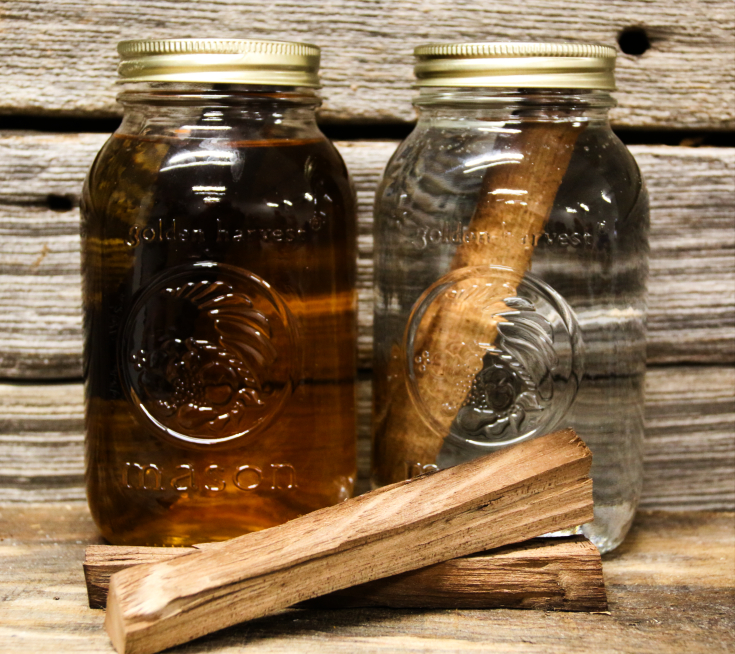
“Aging Homemade Whiskey – A Complete …” from learntomoonshine.com and used with no modifications.
While alcohol content remains stable, a remarkable transformation does occur in properly aged moonshine. The harsh, medicinal qualities of fresh distillate gradually mellow out through oxidation and molecular changes. This chemical evolution creates a smoother, more integrated spirit that delivers its alcohol content more pleasantly on the palate rather than with the burning sensation of fresh shine.
Time allows volatile compounds to settle, harsh fusel alcohols to break down, and flavor molecules to develop greater complexity. These changes don’t make your moonshine stronger, but they do make it considerably more enjoyable to drink. Many experienced distillers agree that even a few months of proper aging can dramatically improve a spirit that was initially difficult to sip. For more insights, you can explore moonshine myths that are commonly discussed among enthusiasts.
Flavor Development and Smoothness
The most noticeable change in aged moonshine is its dramatically improved flavor profile. Fresh off the still, moonshine contains numerous harsh compounds that create a burning sensation and raw alcohol flavor. Over time, chemical reactions break down these compounds into more pleasant-tasting molecules. Methanol and acetone levels decrease, while more desirable esters increase, creating fruity and floral notes that weren’t detectable in the young spirit.
This smoothing effect often leads to the perception of increased strength. When the harshness disappears, you can better taste the true alcohol content without the distracting burn. Many mistakenly interpret this as the shine becoming “stronger” when it’s actually becoming more refined. The spirit isn’t delivering more alcohol to your system; it’s delivering the same amount in a much more palatable package.
Color Transformations
Pure moonshine starts clear as water, but aging—especially in wood—introduces amber, golden, or even deep brown hues. These color changes come from compounds called tannins that leach from wood into the spirit. The visual transformation often reinforces the misconception that the moonshine has somehow concentrated or increased in strength, when it’s actually just extracting color and flavor compounds from the aging vessel.
The darker the spirit becomes, the more people tend to associate it with higher quality and potency. This psychological association plays a significant role in the persistence of the “gets stronger” myth. Our brains connect the rich amber color with the improved flavor and smoother drinking experience, creating an impression of increased potency even when the alcohol percentage remains unchanged.
The Perception of Increased Potency
The human palate can be easily deceived. As moonshine ages and develops complexity, our perception of its strength changes dramatically. The reduction in harshness allows the alcohol to deliver its effects more smoothly, creating what some describe as a “sneakier” drink. Because you don’t experience the immediate burn of raw moonshine, you might not realize how much alcohol you’re consuming until it takes effect.
This perceptual shift is similar to the difference between drinking a sweet mixed cocktail versus taking a shot of vodka. Though they might contain identical amounts of alcohol, the cocktail seems less potent because the alcohol is masked by other flavors. Aged moonshine works similarly—the developed flavors and reduced harshness mask the alcohol sensation without actually changing the alcohol content.
Containers Matter: How Storage Affects Your Shine
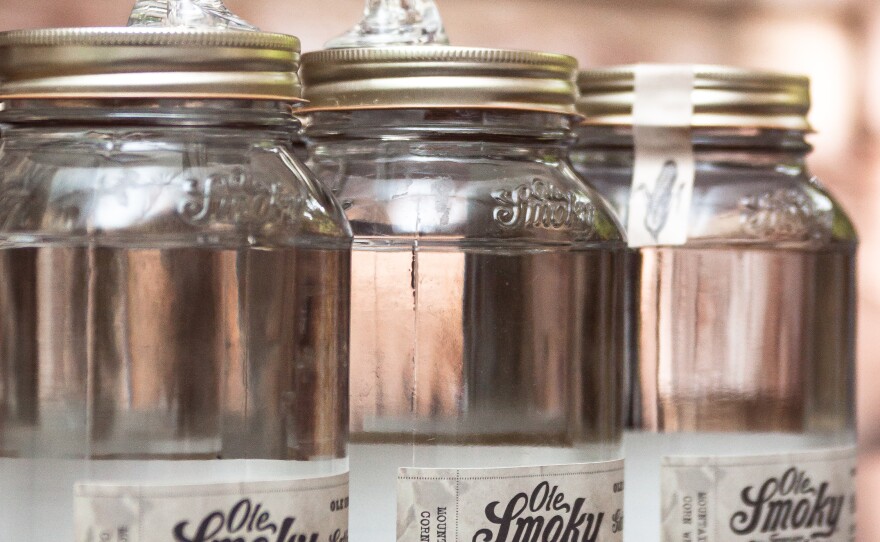
“Moonshine As Moneymaker? Eastern …” from www.kpbs.org and used with no modifications.
The container you choose for storing moonshine dramatically influences how it changes over time. Glass is the most neutral option, allowing minimal interaction between the container and spirit. Mason jars, the traditional vessel for moonshine, preserve the spirit’s character without adding new elements. In contrast, wooden barrels are reactive vessels that continuously exchange compounds with the moonshine, dramatically altering its profile over time.
Plastic containers should generally be avoided for long-term storage. They can leach chemicals into high-proof spirits and allow more oxygen permeation than glass or properly sealed barrels. Metal containers, unless specifically designed for spirits (like some flasks), risk corrosion from the acidic nature of the alcohol, potentially contaminating your moonshine.
Glass vs. Oak: The Critical Difference
The choice between glass and oak represents two fundamentally different approaches to moonshine aging. Glass is preservative—it maintains the spirit almost exactly as it was when bottled, allowing only the most subtle oxidation reactions to occur over time. This makes glass ideal for preserving the character of well-made shine or for spirits that have already completed their desired aging process. For more insights on moonshine, check out 5 Moonshine Myths that are commonly heard.
Oak, conversely, is transformative. A spirit stored in oak undergoes continuous extraction of wood compounds, color changes, and flavor development. The porous nature of wood also allows minimal oxygen exchange, facilitating oxidation reactions that further develop complexity. This is why traditional whiskey producers use oak exclusively—it doesn’t just store the spirit; it actively participates in creating its final character.
Why Commercial Whiskeys Age Differently
Commercial whiskey producers take advantage of barrel aging in ways that home distillers often can’t match. They store thousands of barrels in carefully climate-controlled warehouses where temperature fluctuations cause the spirits to expand and contract, pushing in and out of the wood grain. This “breathing” process accelerates aging and extraction, allowing commercial producers to achieve in 4-6 years what might take much longer in a static home environment.
Additionally, commercial barrels are precisely charred to different specifications based on the desired final product. This char layer acts as a natural filter while also contributing caramelized sugars and vanilla compounds to the aging spirit. Most home distillers use smaller barrels or oak chips, which provide faster wood contact but can’t replicate the precise aging conditions of a Kentucky rickhouse or Scottish warehouse.
The Oxygen Factor in Sealed Containers
Oxygen plays a crucial but often misunderstood role in moonshine aging. In completely sealed glass containers, only the oxygen initially trapped inside can react with the spirit. This limited oxygen supply means oxidation reactions happen very slowly, which preserves the character but limits the beneficial breaking down of harsh compounds. This is why moonshine stored in mason jars changes relatively little compared to barrel-aged spirits.
Barrels, however, allow minute amounts of oxygen to permeate through the wood over time. This slow, controlled oxidation is essential for developing complexity and smoothness. Some home distillers try to mimic this effect by occasionally opening their jars to introduce fresh oxygen—a practice that can help mellow the spirit if done infrequently but risks excessive evaporation if overdone.
Temperature and Environmental Effects
The environment where you store your moonshine significantly impacts how it ages. Consistent cool temperatures slow aging reactions, preserving more of the original character while allowing harsh elements to gradually dissipate. Fluctuating temperatures, particularly warmer conditions, accelerate chemical reactions and extraction from wood if present. This is why distillers in Kentucky get different results than those in Scotland, despite using similar processes.
Light exposure is another critical factor, as UV rays can break down flavor compounds and cause unwanted chemical reactions. This explains the traditional use of blue or clear mason jars stored in dark cellars or cabinets—the environment protects the shine from light degradation while maintaining consistent temperature. Modern distillers often use dark glass or stainless steel for the same protective purpose.
The Origins of the “Gets Stronger” Myth
The persistent belief that moonshine increases in potency over time has deep historical roots in American distilling tradition. During Prohibition, distillers worked quickly and often had to bottle their product immediately after distillation, without the benefit of proper aging. This fresh-off-the-still moonshine was notoriously harsh, with a strong burning sensation that masked its true drinkability. When these same distillers later sampled their product after months of storage, the improved smoothness created a powerful impression of increased strength.
Historical Moonshine Production Practices
Traditional moonshine production often involved imperfect equipment and inconsistent techniques that produced spirits with varying levels of impurities. These congeners and fusel alcohols created the characteristic harshness associated with raw moonshine. As production methods improved and distillers gained experience, they began to recognize the value of allowing their spirits to rest before consumption, debunking some common moonshine myths.
Many historical distillers stored their product in whatever containers were available—often repurposed jugs, jars, or small wooden vessels. Those who happened to use charred wood containers discovered the transformative effects of wood aging, though they lacked the scientific understanding to explain why their shine improved so dramatically. This experiential knowledge passed through generations as folklore rather than science, allowing misconceptions about increasing potency to persist.
How Prohibition Era Beliefs Persist Today
During Prohibition, when scientific measuring equipment was scarce among illicit distillers, subjective taste was the primary method for evaluating moonshine quality and strength. The noticeably improved flavor of aged shine led many to believe it had somehow concentrated or increased in potency. Without hydrometers or other tools to measure actual alcohol content, this perception became accepted wisdom.
This belief system was reinforced by the real observation that barrel-aged commercial spirits lost volume over time due to evaporation—the “angel’s share.” Distillers correctly noted that some liquid was disappearing but incorrectly assumed that it was primarily water evaporating, leaving behind a more concentrated spirit. In reality, alcohol evaporates more readily than water, often slightly reducing proof during barrel aging.
Cultural Traditions and Word-of-Mouth Knowledge
Moonshine production carries strong cultural significance in many rural communities, particularly throughout Appalachia. Recipes and techniques passed down through generations often come bundled with beliefs and practices that may not stand up to scientific scrutiny but remain powerful traditions. The notion that aging improves moonshine is absolutely correct—but the specific belief that it increases alcohol content persists more as cultural knowledge than scientific fact.
For many traditional distillers, the primary evidence for “increased strength” was simply that aged moonshine seemed to have a stronger effect when consumed. This observation has a basis in reality—smoother spirits are often consumed more quickly and with less dilution than harsh ones, potentially leading to more rapid intoxication despite identical alcohol content. This real-world experience reinforced the misconception about increased potency.
How to Properly Age Moonshine for Better Taste

“Oak Aging Barrel Kit (Includes …” from liquidblackjack.com and used with no modifications.
While aging won’t increase your moonshine’s alcohol content, it can dramatically improve its quality when done properly. The key is understanding that you’re not trying to make it stronger—you’re transforming a raw spirit into something more complex and enjoyable. Quality aging focuses on developing flavor while preserving the character that makes moonshine unique in the first place. To explore more about this process, check out our guide on aging moonshine.
Adding Oak Chips for Character
For home distillers without space for barrels, oak chips or cubes offer an excellent alternative for adding wood character to moonshine. American white oak, especially when toasted or charred, contributes vanillin, lactones, and tannins that create the classic bourbon-like notes many enjoy. Simply add 1-2 ounces of oak chips per quart of moonshine and taste weekly until you achieve your desired flavor profile—typically anywhere from 2 weeks to 3 months.
Different toast levels produce distinctly different results. Lightly toasted oak adds subtle vanilla and sweet notes, medium toast contributes caramel and spice characteristics, while heavy char produces more intense smoke and bourbon-like qualities. Many distillers experiment with combinations of different char levels to create unique flavor profiles that can’t be found in commercial products.
For those seeking more control, oak spirals or staves offer more surface area consistency than chips, allowing for more predictable extraction rates. Whatever form you choose, remember that wood aging is easier to add than to remove—start conservatively and increase exposure time as needed rather than over-oaking your precious spirit.
“I’ve tried every aging method imaginable over 30 years of making shine. What I’ve learned is that patience matters more than technique. Whether you use chips, spirals, or small barrels, giving your spirit time to develop is what makes the difference between ordinary and extraordinary.”
Optimal Storage Conditions
Creating ideal aging conditions at home doesn’t require sophisticated equipment, just attention to a few key factors. Temperature stability between 60-70°F (15-21°C) provides the optimal balance between aging speed and control—cooler temperatures slow extraction and oxidation, while warmer temperatures accelerate these processes but can sometimes produce undesirable flavors. Avoid dramatic temperature fluctuations, which can stress the spirit and create inconsistent results.
Protecting your aging moonshine from light exposure is equally important. UV rays break down organic compounds and can create off-flavors in spirits. Store your aging containers in a dark cabinet, closet, or basement, or wrap them in cloth if dark storage isn’t available. If using glass containers, amber or blue glass provides some natural protection against light damage.
Maintaining appropriate humidity levels around 60% helps minimize evaporation if you’re using small barrels. In very dry environments, more alcohol and water will escape through the wood, potentially changing the character faster than intended. In extremely humid environments, the opposite problem occurs—minimal evaporation can slow beneficial concentration of flavors.
When to Stop the Aging Process
Unlike commercial whiskey with strict age statements, moonshine aging should be guided by taste rather than time. The optimal aging period depends entirely on your personal preference and the specific characteristics of your distillate. Regular tasting—perhaps weekly for rapid-aging methods like chips or small barrels—allows you to track development and stop when the spirit reaches your ideal profile.
When you detect that your moonshine has developed the complexity and smoothness you desire, transfer it to neutral glass containers to halt the wood extraction process. This “resting period” in glass allows the newly developed flavors to integrate and settle for at least a few weeks before making final judgments on quality. Many distillers find that this integration period reveals subtleties that weren’t apparent immediately after wood aging.
Is Your Moonshine Safe After Years of Storage?
One advantage of properly made moonshine is its remarkable shelf stability. Unlike wine or beer, distilled spirits with sufficient alcohol content (typically above 40% ABV) are essentially self-preserving and resistant to microbial contamination. A properly sealed jar of moonshine can remain safe to drink for decades with minimal quality degradation, though subtle changes in flavor may occur through slow oxidation. For those interested in how storage methods can affect flavor, you might want to explore the differences between aging moonshine in glass vs oak.
Shelf Life Considerations
Pure, unflavored moonshine stored in properly sealed glass containers has an almost indefinite shelf life. The high alcohol content creates an environment hostile to bacteria and other microorganisms that cause spoilage. Some of the oldest documented moonshine samples date back 50+ years and remain perfectly safe to consume, though their flavor profiles have evolved over time.
Flavored moonshines present different considerations. Those containing added sugars, fruits, or other organic materials have shorter shelf lives and should generally be consumed within 1-2 years of production. These additions introduce compounds that can degrade over time, potentially affecting both flavor and appearance. Refrigeration can extend the quality life of flavored moonshines substantially.
Signs of Spoilage to Watch For
While true spoilage is rare in properly made moonshine, certain warning signs should never be ignored. Any visible particulate matter that wasn’t present when bottled—especially floating particles or cloudy appearance that developed during storage—warrants caution. Significant changes in color (darkening or developing strange hues) or unusual sediment formation can also indicate chemical changes that might affect safety.
The most reliable indicator remains your senses. Any off-putting or unusual odors, particularly those reminiscent of nail polish remover (acetone), glue, or rotten eggs, suggest potential problems with the spirit. Similarly, any dramatic changes in taste profile, especially the development of bitter, metallic, or chemical flavors, should raise red flags. When in doubt about an aged moonshine’s safety, the wise approach is to discard it rather than risk consumption.
Health and Safety Concerns
The primary safety concern with aged moonshine isn’t bacterial contamination but rather the potential presence of harmful compounds from improper distillation. Methanol, the most notorious of these compounds, doesn’t increase during storage—if your moonshine was safely made with proper cuts (separating the foreshots and heads), it remains safe regardless of age. However, no amount of aging can make an improperly distilled spirit safe to drink.
Another consideration is storage container safety. Moonshine should only be aged in food-grade containers designed for high-proof alcohol. Traditional glass mason jars are ideal, as are purpose-made aging vessels like oak barrels. Avoid containers made from soft plastics, lead crystal, or metals that might corrode when exposed to alcohol, as these materials can leach harmful compounds into your spirit over time. For more information on the differences between storage options, check out this article on aging moonshine in glass vs oak.
For long-term storage, regular inspection helps identify potential issues before they become serious. Check stored moonshine periodically for seal integrity, unusual appearance changes, or off odors. Transferring older moonshine to fresh containers with new seals every few years can help ensure continued quality and safety, particularly if the original seals show signs of deterioration.
Understanding how alcohol affects individual health is also essential for responsible consumption. While properly made moonshine isn’t inherently more dangerous than commercial spirits of equivalent proof, its often higher alcohol content demands greater moderation. The smoothness that develops with age can mask the high alcohol content, potentially leading to overconsumption if you’re not mindful of serving sizes.
- Always store moonshine in food-grade containers specifically suited for high-proof alcohol
- Inspect stored spirits regularly for visual changes, off odors, or seal deterioration
- Consider transferring aged moonshine to fresh containers every 3-5 years
- Remember that smoothness from aging doesn’t reduce alcohol content or potential for intoxication
- When in doubt about safety, discard questionable spirits rather than risking consumption
Better Ways to Adjust Moonshine’s Potency
If your goal is actually adjusting the strength of your moonshine rather than simply improving its character, there are reliable methods that don’t involve hoping for mythical increases during aging. Understanding and controlling alcohol content begins during the distillation process itself, with final adjustments made through careful dilution techniques.
Distillation Techniques for Higher Proof
The most effective way to control moonshine potency happens during distillation, not after. Multiple distillation runs can progressively increase alcohol concentration, with each pass removing more water and concentrating the ethanol. Traditional pot stills typically produce spirit around 100-120 proof on the first run, but a second distillation (sometimes called a “spirit run”) can achieve 140-160 proof or higher depending on still design and operation.
Temperature management during distillation profoundly affects final proof. Ethanol boils at 173.1°F (78.4°C) while water boils at 212°F (100°C). By carefully controlling still temperature to remain closer to ethanol’s boiling point, you can collect a higher concentration of alcohol in your distillate. However, this requires precise temperature control and often sacrifices some flavor compounds that boil at higher temperatures.
The design of your still’s condenser and the rate of cooling also impact final proof. More efficient condensation captures a higher percentage of alcohol vapors, potentially increasing the proof of your collected spirit. Slow distillation generally produces higher proof than rapid runs, as it allows for better separation of alcohol from water during the vaporization and condensation process. For more insights on when to stop distilling, check out this guide on how to know when to stop distilling.
“The difference between 100 proof and 160 proof isn’t time in the jar—it’s attention to detail during distillation. Getting high proof moonshine is about mastering your still, not waiting for magic to happen in storage.”
Dilution Methods for Perfect Strength
Most traditional moonshine is consumed at lower proof than it comes off the still. Dilution with pure water allows you to precisely adjust your moonshine to your preferred drinking strength. The standard approach is to measure your initial proof with an accurate alcoholmeter or hydrometer, then calculate the amount of water needed to reach your target proof. Adding this water gradually while measuring results ensures accuracy.
The timing of dilution matters significantly. Many experienced distillers recommend diluting immediately after distillation, before aging or flavoring. This “proofing down” process allows the spirit to integrate with the added water during aging, resulting in a more cohesive final product. Others prefer to age at full strength, then dilute just before bottling to preserve maximum flavor intensity during the aging process.
- Use only distilled or spring water for dilution to avoid introducing chlorine or minerals
- Add water gradually in small increments, mixing thoroughly between additions
- Allow diluted spirit to rest for at least 24-48 hours before final assessment
- Consider that flavoring ingredients may affect final proof through their water content
- Document your dilution ratios for consistency in future batches
Temperature affects hydrometer readings, so ensure your moonshine is at the calibration temperature of your measuring device (typically 60°F/15.56°C) for accurate measurements. A difference of just a few degrees can significantly impact readings, leading to incorrect dilution calculations. For precision, temperature correction tables are available to adjust readings taken at different temperatures.
When diluting high-proof moonshine, be aware that mixing water and alcohol creates an exothermic reaction that generates heat. This temperature increase can temporarily affect volume measurements. For the most accurate results, make your dilutions in small batches, allowing each to cool to room temperature before taking final measurements and proceeding with additional adjustments.
Flavoring Without Affecting Alcohol Content
Adding flavors to moonshine provides another dimension of customization while potentially making higher-proof spirits more approachable. Infusion with dried ingredients—like spices, wood chips, or dried fruits—adds minimal water content and therefore has negligible impact on proof. This allows you to create complex flavored spirits while maintaining your desired strength, unlike fresh fruit infusions which can significantly reduce alcohol percentage through their high water content. For more details on creating flavored spirits, check out this guide on how to make infused moonshine.
The Truth About Moonshine Matters More Than Myths
Understanding the reality of how moonshine ages empowers you to make better decisions about production and storage. Rather than chasing the myth of increasing potency through aging, focus on the very real benefits of proper maturation: improved flavor, reduced harshness, and development of complex character. These tangible improvements make aged moonshine more enjoyable without any need for mystical increases in alcohol content.
By separating fact from fiction, you can approach moonshine making with greater knowledge and control. The traditional wisdom passed down through generations contains valuable insights about flavor development and aging techniques, even if some of the explanations behind these practices have been misunderstood. Embrace the genuine craft of creating quality spirits while leaving behind the misconceptions that don’t stand up to scientific scrutiny. At Best Moonshine Still, we’re dedicated to preserving traditional distilling methods while providing accurate information that helps home distillers create exceptional spirits safely and legally.
Frequently Asked Questions
After years of answering questions from fellow home distillers, I’ve found that certain misconceptions about moonshine aging and potency come up repeatedly. Here are straightforward answers to the most common questions about how moonshine changes over time.
Can I increase my moonshine’s alcohol percentage after distillation?
No, you cannot increase the alcohol percentage of moonshine after distillation through any aging or storage method. The alcohol content is fixed during the distillation process and will remain stable or slightly decrease over time due to minimal evaporation. The only way to increase alcohol content after production would be through freeze distillation (concentrating by freezing out water), which is both illegal in many jurisdictions and potentially dangerous due to concentration of harmful compounds.
Is it dangerous to drink very old moonshine?
Properly made and stored moonshine remains safe to drink indefinitely, regardless of age. The high alcohol content prevents microbial growth that could make it dangerous. However, moonshine stored in inappropriate containers (like certain metals or plastics) could potentially leach harmful compounds over time. Additionally, moonshine that was improperly made with excessive methanol would remain dangerous regardless of how long it aged. Age itself doesn’t make good moonshine dangerous or bad moonshine safe.
Why does my aged moonshine taste smoother but seem stronger?
This common perception comes from how aging affects the sensory experience of drinking moonshine. As harsh compounds break down and flavors develop, the initial burning sensation diminishes, allowing you to better taste the true character and strength of the spirit. Without the distraction of harshness, you’re experiencing the full impact of the alcohol that was always present.
Additionally, developed flavors in aged moonshine can enhance the overall sensory intensity, creating a more powerful taste experience that might be interpreted as increased strength. The smoother delivery also means you might consume more or drink it faster than you would harsh, fresh moonshine, potentially leading to a stronger physiological effect despite identical alcohol content.
Does flavored moonshine age differently than unflavored?
Yes, flavored moonshine ages quite differently from unflavored. Added ingredients—especially those containing sugars, acids, or oils—introduce new compounds that undergo their own chemical changes during storage. Fruits and spices continue to infuse their flavors over time, often reaching peak intensity after weeks or months before potentially fading during extended aging. This evolution creates a more complex aging trajectory than pure moonshine, which changes more predictably and gradually.
What’s the ideal proof for moonshine before aging begins?
The ideal proof for aging moonshine depends on your aging method and desired final product. For oak barrel aging, many distillers prefer starting around 100-125 proof (50-62.5% ABV), as this concentration effectively extracts wood compounds without becoming overpowering. Higher proofs (above 140) can extract harsher tannins too quickly, while lower proofs (below 80) might not extract enough character from the wood. For more insights, you can explore the differences between aging moonshine in glass vs. oak.
For glass storage without wood, starting proof has less impact on aging chemistry, though oxidation reactions occur differently at various alcohol concentrations. Many traditional moonshiners store their spirit at full strength as it comes off the still, then dilute to taste before consumption. This preserves maximum flexibility for future use while minimizing storage space requirements. For more insights, explore the differences in aging moonshine in glass vs oak.
Remember that aging is about enhancing character, not increasing strength. Focus on creating the best possible distillate first, then use aging to refine and improve that foundation. With proper techniques and patience, your moonshine will develop remarkable complexity and smoothness while maintaining the unique character that makes homemade spirits special. For more detailed guides on home distilling equipment and techniques, visit Best Moonshine Still, your trusted resource for everything related to traditional spirit making.
Moonshine is often associated with high potency and a distinctive burn. Many enthusiasts wonder if aging moonshine can enhance its flavor or increase its strength. While traditional whiskey benefits from aging in barrels, moonshine typically does not undergo this process. However, some believe that storing moonshine in oak barrels can mellow its harshness over time. To explore more about this topic, check out this discussion on aging moonshine and its effects.

